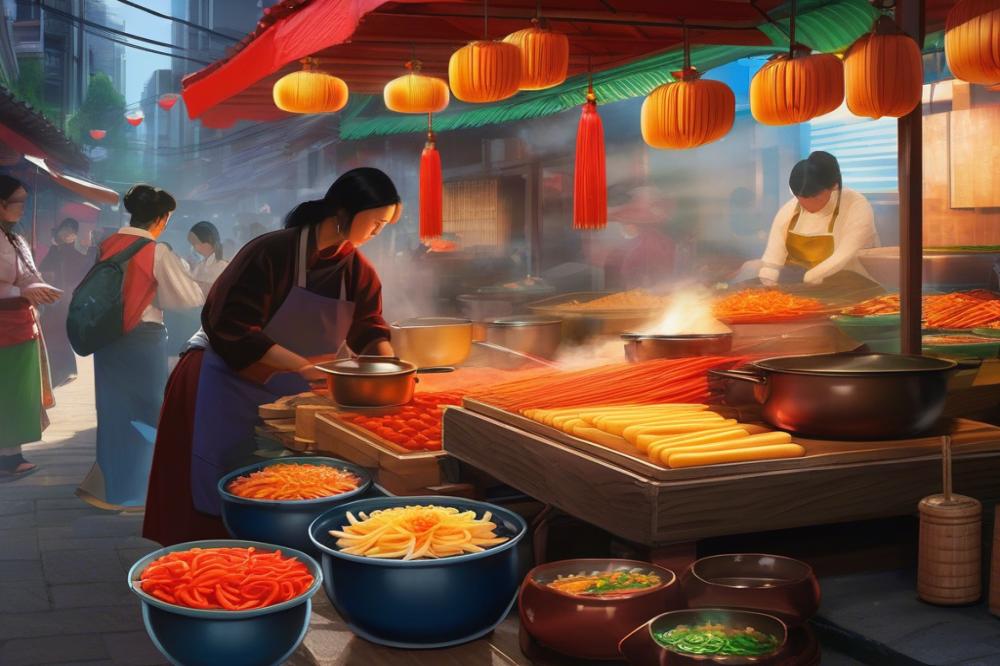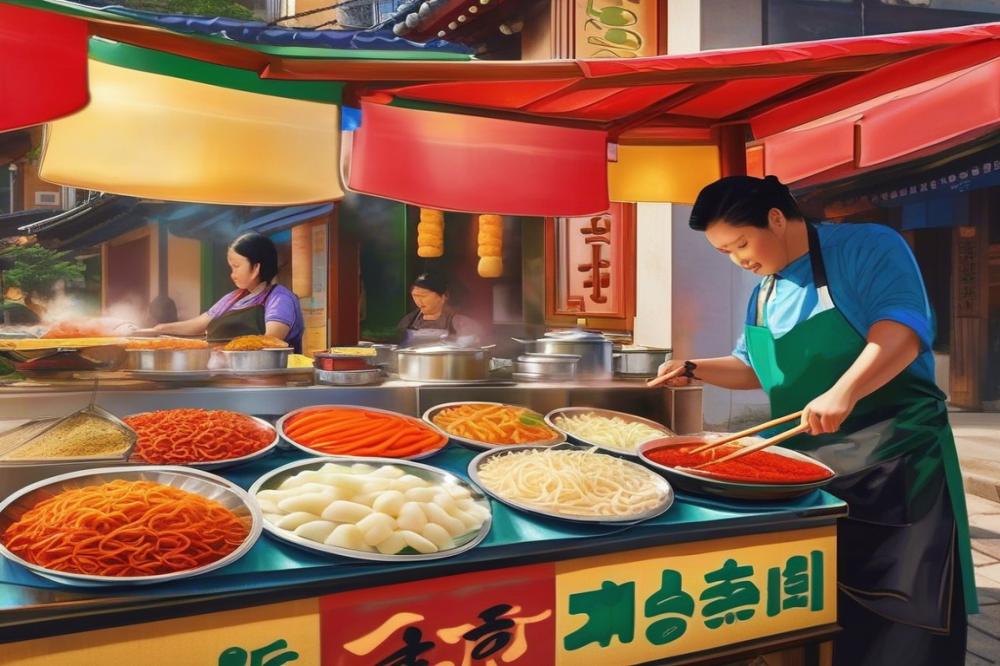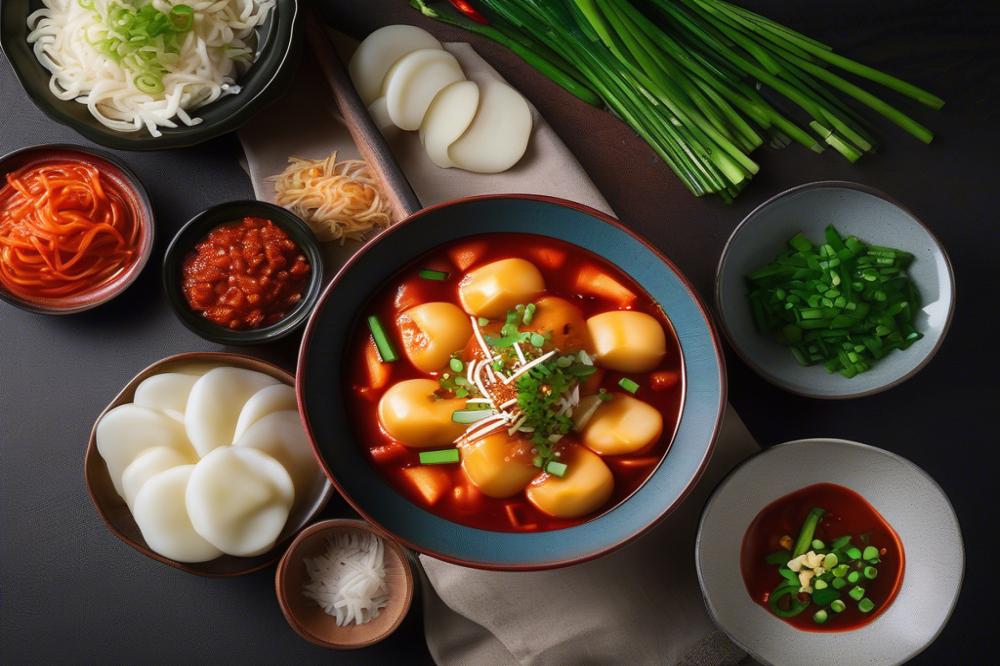Introduction
Tteokbokki, a beloved dish in Korean cuisine, features chewy rice cakes that are often bathed in a rich, spicy sauce. This dish holds a special place in the hearts of many. It represents the vibrant culinary traditions of South Korea, showcasing both its flavors and textures. The combination of rice cakes and hot pepper paste, known as gochujang, creates a dish filled with comfort and satisfaction.
The importance of this meal extends beyond just its taste. Many street food vendors proudly serve Tteokbokki, making it a staple at markets and food stalls. As people stroll through bustling streets, the aroma of simmering spicy rice cakes enchants their senses. It’s a common snack that brings people together, often enjoyed while chatting with friends or on the go.
Comfort food takes on a new meaning with this dish. The warmth and spice ignite a sense of nostalgia for those who have enjoyed it since childhood. The recipe varies greatly, allowing for personal touches. Some add vegetables like cabbage or fish cakes, while others may enhance the flavor with sesame seeds or boiled eggs. Cooking tips abound, helping aspiring cooks create their own version at home.
Food history shows that Tteokbokki has evolved over the years. Once a dish reserved for special occasions, it transformed into a favorite quick meal for many. Today, it embodies the essence of South Korean street food culture, appealing to both locals and tourists alike. Spicy dishes capture the essence of Korean flavors, and Tteokbokki proves to be a perfect ambassador for this culinary journey.
What is Tteokbokki

Tteokbokki refers to spicy rice cakes that hold a special place in Korean cuisine. These delicious snacks are made from chewy rice flour cakes and often cooked in a flavorful sauce. At the heart of this dish is gochujang, a red chili paste that gives it its characteristic heat and depth of flavor. Many people enjoy this dish as a street food treat, but it can also be found in restaurants and homes across South Korea.
Historical Background and Evolution
The history of tteokbokki stretches back hundreds of years, with roots in royal cuisine. Originally, it was made without chili, focusing on savory flavors instead. The introduction of gochujang in the 19th century changed everything. Suddenly, spicy flavors captured the attention of the masses. Over time, recipes grew more diverse as street vendors began to sell different versions of the dish. Today, it is common to find countless variations all around Korea, reflecting both tradition and modernity.
Culinary Traditions Associated with Tteokbokki
This dish represents more than just food; it is intertwined with culinary traditions. Street food markets buzz with energy, filled with the aroma of frying cakes and simmering sauce. People gather around vendors, chatting while waiting for their spicy treat. Tteokbokki is often served with fish cake, cabbage, and boiled eggs, creating a comforting meal. Food history reveals how this dish has evolved from a royal delicacy to a beloved snack for everyone. Cooking tips can help anyone recreate this experience at home, making it a great option for gatherings with friends and family.
Ingredients for Tteokbokki

To craft a delicious plate of spicy rice cakes, gathering the right ingredients is crucial. Here’s a list of what you’ll need:
- Korean rice cakes (Tteok): 300g
- Gochujang (Korean red chili paste): 3 tablespoons
- Gochugaru (Korean red chili flakes): 1 teaspoon
- Sugar: 1 tablespoon
- Soy sauce: 1 tablespoon
- Green onions: 2 stalks, chopped
- Fish cakes: 100g, sliced
- Water: 2 cups
- Sesame oil: 1 teaspoon
Nutritional Information for Each Ingredient
Korean rice cakes provide a chewy base packed with carbohydrates, fueling your energy needs. Next, gochujang introduces deep flavor and spice, enhancing your culinary experience. Each tablespoon of gochugaru adds a rich color and a mild smokiness to the dish.
Sugar balances the heat and boasts about 15 calories per tablespoon. Soy sauce, with its savory umami punch, contributes sodium and a touch of sweetness. Green onions not only bring freshness but also a bit of crunch. They are low in calories, making them a healthy addition.
Fish cakes, a popular ingredient in Korean street food, add protein and a distinctive taste. While seemingly simple, they enrich the overall flavor. Water acts as the base for the sauce, helping all the flavors meld perfectly together.
Finally, sesame oil adds a nutty aroma that elevates the dish. This ingredient brings healthy fats and contributes to the comfort food aspect, making your meal satisfying. Knowing these nutritional details enhances your cooking tips and can provide insight into the culinary traditions behind this beloved recipe.
Cooking Instructions

Preparation of Ingredients
Gather all the necessary ingredients before starting. For this dish, you will need rice cakes, fish cakes, and boiled eggs. Fresh vegetables like green onions and cabbage add a nice touch. Also, have gochujang, soy sauce, and sugar ready to create the sauce. Gochugaru, or Korean red pepper flakes, can add extra heat if desired. Before cooking, soak the rice cakes in warm water for about 30 minutes. This step helps soften them for cooking. The freshness of your ingredients makes a significant difference in taste.
Cooking Steps
Begin by heating a pan on medium heat. Add the sauce mixture of gochujang, soy sauce, and sugar to the pan. Stir until well blended, and then add water to create a smooth base. It’s important to find the right balance of these flavors. Another key step is to toss in your soaked rice cakes. Simmer everything together for about 10 minutes. Stir occasionally to prevent sticking, and keep an eye on the sauce as it thickens. After the rice cakes soften, add fish cakes and vegetables. Continue to stir until everything is well coated in the sauce. The aroma will fill your kitchen, a wonderful sign you’re on the right track.
Tips for Perfect Texture and Flavor
For a great experience, focus on the texture of the rice cakes. If they become too soft, they may lose their unique chewiness. Keep the heat steady. Too high can burn the sauce, while too low may not cook the rice cakes thoroughly. Adding a splash of water helps if things thicken too quickly. Taste as you go. Adjusting the spice with more gochugaru can cater to your heat preference. There’s beauty in simplicity, so don’t overload the dish with too many ingredients. Pair your meal with a refreshing beverage for balance. Enjoy the process; it’s more than just a recipe; it’s a glimpse into Korean culinary traditions.
Variations and Creative Twists

Tteokbokki is not just a simple dish but a canvas for creativity. Different regions in Korea celebrate their own versions of this street food favorite. In Seoul, you might find a thicker sauce, while Busan tends to serve it with fish cakes. These regional recipes reflect local tastes and food history.
Some cooks add twist snacks, introducing elements like cheese or even instant ramen. This fusion adaptation appeals to many. Gochujang remains a key ingredient, but other spices can create exciting flavor profiles. For those who crave something different, a recipe using kimchi brings a delightful tanginess alongside the heat.
Customization is essential for many families. Preferences vary—some love a mild kick, while others desire fiery levels. Cooking tips include adjusting the amount of gochujang or adding ingredients like onions and garlic. Vegetarians might enjoy alternatives like mushrooms, while meat lovers can consider adding minced pork or shrimp.
Each addition changes the dish’s character and highlights the versatility of this comfort food in Korean cuisine. Seasonal vegetables can also enhance the taste and nutrition. Explore which combination feels most satisfying on the palate. Don’t be afraid to experiment; the joy of cooking lies in discovery.
Cooking Tips for Perfect Tteokbokki
Achieving the right spice level is an essential part of the preparation. Start with gochujang, a staple in Korean cuisine. This chili paste brings heat and depth to the dish. Adjust the amount based on your preference. If you like it milder, add less initially. You can always add more later as it cooks.
Enhancing Flavor and Texture
For a richer flavor, consider adding some gochugaru, which is Korean red pepper flakes. This ingredient adds a smoky element that enriches the dish. Incorporating soy sauce can also boost umami notes. Pairing the rice cakes with sliced fish cakes or boiled eggs creates a wonderful mix. Cooking them in a savory broth instead of plain water elevates the experience. A homemade anchovy or kelp stock can deepen the taste significantly.
Avoiding Common Mistakes
Many people overlook the cooking time. Overcooking the rice cakes can lead to a gummy texture. Stir frequently but gently to prevent sticking. When it comes to the sauce, balance is key. Too much sugar can mask the spiciness. Taste as you go! This approach helps avoid an overly sweet flavor.
Also, watch the thickness of your sauce. A thin consistency may not cling well to the cakes. Add water gradually, being careful to keep it thick but saucy. Finally, serve your dish with optional toppings like sesame seeds or chopped green onions. These small additions can take your snack to another level. Embrace the culinary traditions of this dish, and enjoy every bite of your spicy street food creation!
Cultural Significance and Popularity
Role of Tteokbokki in Korean street food culture
Street food holds a special place in Korean cuisine. Tteokbokki is one of the most beloved snacks found in bustling markets and on busy streets. Vendors prepare this dish right in front of customers, adding a layer of excitement to the meal. The spicy rice cakes attract people of all ages. Many enjoy watching the vendor skillfully stir the ingredients together, a performance in itself. Gochujang, a key component, provides that classic heat which makes this dish so crave-worthy.
How Tteokbokki is enjoyed in various settings
People eat this dish in many different ways. Some enjoy it as a quick snack after school, while others savor it during casual dinners with friends. It pairs well with drinks, making it a popular choice in pubs. Additionally, a recipe can be adapted for home cooking, allowing families to create their own version. Food history shows that it has evolved over time but always remains comforting. Sharing a plate of the spicy dish encourages conversation and laughter, enhancing the eating experience.
Connection to Korean festivals and gatherings
Festivals often feature Tteokbokki as a highlight. At events, large pots bubble away, drawing in crowds with their tantalizing smells. It’s not unusual to find stalls dedicated solely to this dish during celebrations. Gathering with family and friends around a steaming plate fosters a sense of togetherness. The spicy flavors and warm texture add to the festive spirit. Traditional culinary traditions continue to include this snack, ensuring that it remains an integral part of social occasions. Nothing brings people together quite like sharing delightful, spicy dishes that evoke memories and create new ones.
The Joy of Tteokbokki
This famed dish stands out as a cherished snack within Korean cuisine. Known for its delightful texture and spicy sweetness, it has captured the hearts of many. Tteokbokki is not just food; it embodies comfort and nostalgia for countless people. Street food vendors across South Korea serve it hot, often garnished with fish cakes, boiled eggs, or green onions. Each bite offers a taste of warmth and satisfaction.
Why not embark on the journey of crafting this beloved dish in your own kitchen? Preparing this snack at home allows you to customize the flavors to your liking. Adjust the spice levels, mix in favorite ingredients, or even experiment with unique toppings. It’s a fun way to connect with Korean culture and share a piece of it with your family and friends.
Embracing the act of cooking can lead to delightful results. Bringing tteokbokki into your culinary repertoire not only fills the stomach but also nourishes the soul. This dish is a reminder of how food can evoke feelings of joy and connection. As you take each bite, appreciate the rich history and culture behind this iconic comfort food.



